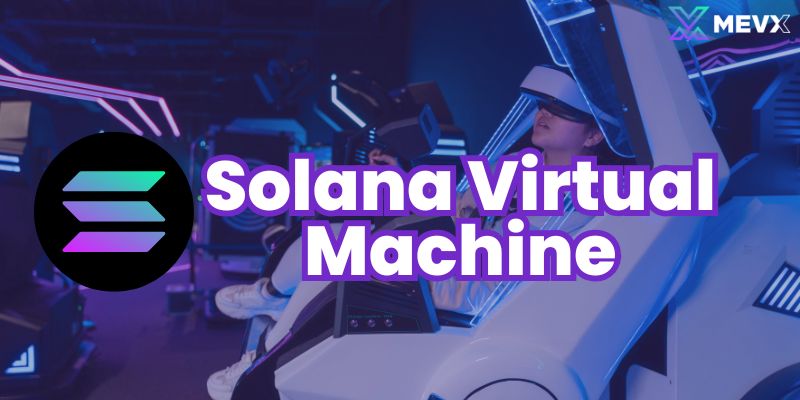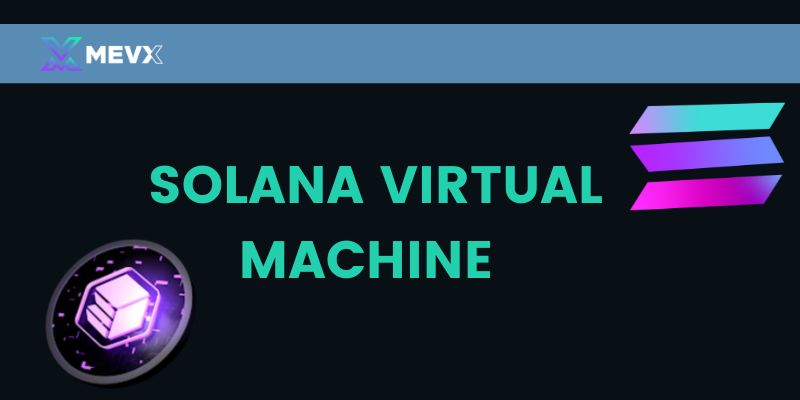What is Solana Virtual Machine? The Solana Virtual Machine (SVM) is a powerful execution environment that drives the speed and scalability of the Solana blockchain. By enabling fast, parallel processing of smart contracts and decentralized applications, the SVM is a game-changer, allowing Solana to handle thousands of transactions per second.
Contents
ToggleWhat is Solana Virtual Machine?
At its core, the Solana Virtual Machine (SVM) is an execution environment designed to process smart contracts and decentralized applications (dApps) on the Solana blockchain. The Solana blockchain itself is known for its incredibly fast transaction speeds, capable of processing over 65,000 transactions per second (TPS), and a low-cost transaction model. The SVM is integral to achieving this level of performance and scalability.
Similar to other blockchain virtual machines like the Ethereum Virtual Machine (EVM), the Solana Virtual Machine enables developers to deploy smart contracts that can execute complex logic, transfer assets, and interact with other smart contracts. However, the Solana Virtual Machine has been designed from the ground up to be more efficient, allowing Solana to process transactions at such high speeds.

Key Features of the Solana Virtual Machine
The Solana Virtual Machine is unique in several aspects, primarily due to its design, speed, and performance. Here are the most important features that set it apart:
High Throughput
One of the standout features of the Solana Virtual Machine is its ability to process thousands of transactions per second. While Ethereum’s EVM struggles to handle a high volume of transactions, Solana’s approach allows the blockchain to scale horizontally. This means that the Solana Virtual Machine can run multiple smart contracts and dApps simultaneously without compromising on speed, making it ideal for high-demand applications.
Low Latency
Latency is another key advantage of the Solana Virtual Machine. The time it takes for a transaction to be processed is minimal, making Solana one of the fastest blockchains in existence. With such low latency, Solana is capable of supporting real-time applications like decentralized exchanges (DEXs), gaming platforms, and financial services that require immediate feedback and transaction finality.
Parallel Execution
The Solana Virtual Machine utilizes a unique architecture known as “Sealevel,” which allows it to process multiple transactions in parallel. Unlike traditional blockchain networks where transactions are processed sequentially, Solana can handle many transactions at once, drastically increasing throughput and reducing bottlenecks. This parallel execution model is a key factor in the scalability and efficiency of the Solana blockchain.
Optimized for Performance
Solana’s virtual machine is optimized for performance, allowing developers to write high-performance smart contracts that are both cost-effective and efficient. This is achieved through the use of a Rust-based programming language for smart contracts, which is known for its performance and memory safety.
How Does the Solana Virtual Machine Work?
To understand how the Solana Virtual Machine works, it’s important to first know how the Solana blockchain operates as a whole. Solana employs a proof-of-history (PoH) consensus mechanism, which is a time-stamping protocol that ensures transactions are ordered correctly. This mechanism helps the Solana blockchain process transactions quickly without the need for a traditional proof-of-work (PoW) or proof-of-stake (PoS) system.
When a smart contract or dApp is executed on the Solana blockchain, it is processed by the Solana Virtual Machine. The virtual machine is responsible for verifying the transaction’s validity, ensuring the contract executes properly, and interacting with other parts of the blockchain if necessary. The Solana Virtual Machine handles everything from basic token transfers to complex smart contract logic, making it the backbone of decentralized applications on the Solana network.
The high performance of the SVM comes from Solana’s ability to execute transactions in parallel. It breaks transactions into smaller, independent tasks that can be processed simultaneously across different threads. This results in a highly efficient execution model that ensures fast transaction confirmation times.

Solana Virtual Machine vs Ethereum Virtual Machine
When comparing the Solana Virtual Machine to the Ethereum Virtual Machine, there are several key differences. Ethereum’s EVM has been the standard for smart contract execution for years, but it has faced limitations in scalability and performance. Solana’s SVM, on the other hand, was designed with scalability in mind from the beginning.
While the Ethereum Virtual Machine processes transactions sequentially, Solana’s SVM can process them in parallel, allowing for much greater throughput. Furthermore, Solana’s use of proof-of-history adds another layer of efficiency, making the network even faster than Ethereum in terms of transaction finality and speed.
However, Ethereum still holds an advantage in terms of developer adoption, with a much larger ecosystem of dApps and developers. Solana is still catching up in this regard, but its high performance and growing ecosystem make it an attractive option for developers looking for scalability and speed.
Why is the Solana Virtual Machine Important for the Blockchain Ecosystem?
The Solana Virtual Machine is a crucial component of Solana’s overall design, enabling the blockchain to perform at unprecedented speeds. This makes Solana an appealing option for developers who need a blockchain that can handle high transaction volumes without compromising on speed or security. Here are some reasons why the SVM is important:
- Scalability
As the demand for blockchain applications continues to grow, scalability becomes a major concern. The Solana Virtual Machine’s parallel execution model allows it to scale easily and handle a large number of transactions. This makes it an ideal platform for decentralized finance (DeFi) applications, gaming, NFTs, and other use cases that require high throughput.
- Low Fees
One of the significant advantages of the Solana blockchain is its low transaction fees, which is made possible by the efficiency of the Solana Virtual Machine. By processing transactions quickly and efficiently, the Solana blockchain can keep fees low, even during periods of high network activity. This is a stark contrast to Ethereum, where fees can skyrocket during times of congestion.
- Real-Time Applications
For developers building applications that require real-time interactions, such as gaming or financial platforms, the Solana Virtual Machine provides an excellent environment. Its low latency and high throughput allow these applications to run smoothly, providing users with a seamless experience.
The Future of Solana and the Virtual Machine
As Solana continues to gain traction in the blockchain space, the Solana Virtual Machine is expected to evolve and improve. With ongoing updates and optimizations, the SVM is poised to become an even more powerful tool for developers, enabling the creation of next-generation decentralized applications.
The Solana ecosystem is expanding, with more dApps, decentralized exchanges, and blockchain projects being built on top of it. This growth will likely increase the demand for high-performance solutions like the Solana Virtual Machine, further cementing its place as a leader in the blockchain industry.
Exploring New Possibilities with Solana Virtual Machine
The Solana Virtual Machine is an essential component of what makes the Solana blockchain one of the fastest and most scalable networks in the world. By leveraging parallel execution, proof-of-history, and a high-performance execution environment, the SVM empowers developers to create decentralized applications that can handle high traffic and provide real-time interactions.
As the blockchain space continues to grow, the Solana Virtual Machine will undoubtedly play a key role in the development of innovative solutions across various industries. If you’re a developer looking to build the next big thing on Solana, or an investor interested in the future of blockchain technology, now is the time to explore the possibilities that the Solana Virtual Machine offers.
Interested in learning more about optimizing your blockchain experience? Explore MevX, a platform that can help you navigate the complex world of decentralized finance, making the most out of your Solana and other blockchain applications. Whether you’re building or investing, MevX offers valuable insights and tools to accelerate your success in the Web3 space.
